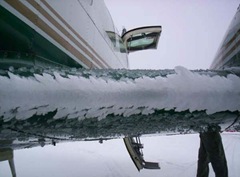The Associated Press has reported the results of an National Transportation Safety Board (NTSB) accident report which concluded that a pilot’s inability or reluctance to fly quickly enough out of icing condition led to the deaths of  all five people aboard the aircraft (including the pilot’s wife and two children).
all five people aboard the aircraft (including the pilot’s wife and two children).
The pilot of the single-engine Socata TBM 700 had more than 1,400 hours of flight time and had departed from the Teterboro Airport in New Jersey en route to Georgia when the aircraft spiraled out of control at 17,000 feet and crashed on a wooded highway median with wreckage scattered over half a mile – forcing a closure of the highway for several hours.
According to the accident report, air traffic control had told the pilot about moderate icing from 15,000 to 17,000 feet and the pilot responded by saying:
We’ll let you know what happens when we get in there and if we could go straight through, it’s no problem for us.
The controller then directed him to climb to 17,000 feet, but when the pilot reached 16,800 feet, he reported reported light icing and said that “a higher altitude would be great.” A few moments later, the aircraft began to experience rattling and the pilot asked to be cleared for a higher altitude “as soon as possible please.”
He was and within about a minute, the aircraft had reached 17,800 feet and then began an uncontrolled descent. Investigators were also told by other pilots in the area about icing with one pilot saying his wing anti-icing system “couldn’t keep up” with ice accumulation of as much as 4 inches that had developed over the course of just five minutes.
The NTSB concluded:
The airplane’s encounter with unforecasted severe icing conditions that were characterized by high ice accretion rates and the pilot’s failure to use his command authority to depart the icing conditions in an expeditious manner, which resulted in a loss of airplane control.
In other words and if you encounter icing or other potentially dangerous conditions, you need to make a decisive decision and act fast.
Leave a Reply